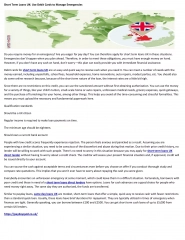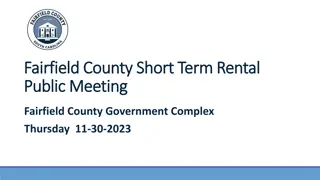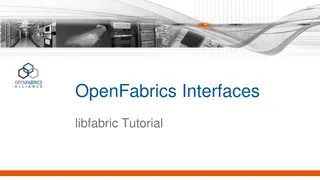
Essential Guide to Installing and Using R for Statistical Analysis
Learn how to install and use R, a free open-source statistical analysis software with excellent visualization features. Discover the basics of R programming, including variable declaration, script writing, and package installation. Follow step-by-step instructions for setting up R, running scripts, managing objects, and enhancing your data analysis skills.
Download Presentation

Please find below an Image/Link to download the presentation.
The content on the website is provided AS IS for your information and personal use only. It may not be sold, licensed, or shared on other websites without obtaining consent from the author. If you encounter any issues during the download, it is possible that the publisher has removed the file from their server.
You are allowed to download the files provided on this website for personal or commercial use, subject to the condition that they are used lawfully. All files are the property of their respective owners.
The content on the website is provided AS IS for your information and personal use only. It may not be sold, licensed, or shared on other websites without obtaining consent from the author.
E N D
Presentation Transcript
Arko Barman COSC 6335 Data Mining Fall 2014
Free, open source statistical analysis software Competitor to commercial softwares like MATLAB and SAS none of which are free Need to install only basic functionalities Install packages as and when needed somewhat like Python Excellent visualization features!
Link for installation: http://cran.r-project.org/mirrors.html Choose a mirror link to download and install Latest version is R-3.1.1 Choose default options for installation Don t worry about customizing startup options! Just click Okay , Next and Finish !
R is an interpreter Case sensitive Comment lines start with # Variable names can be alphanumeric, can contain . and _ Variable names must start with a letter or . Names starting with . cannot have a digit as the second character To use an additional package, use library(<name>) e.g. library(matrixStats) Package you are trying to use must be installed before using
Variable declaration not needed (like MATLAB) Variables are also called objects Commands are separated by ; or newline If a command is not complete at the end of a newline, prompt shows + Use command q() to quit For help on a command, use help(<command>) or ?<command name> For examples using a command, use example(<command>)
setwd(<folder_name>) source(<script_file>) runs the R script <script_file> sink(<output_file>) saves outputs to <output_file> sink() restores output to console ls() prints list of objects in workspace rm(<object1>, <object2>, ) removes objects from workspace
Writing scripts - use Notepad/Notepad++ and save with extension .r OR use Rcmdr package Installing a package - Packages>Install package(s) choose the package you want to install
assign("x", c(10.4, 5.6, 3.1, 6.4, 21.7)) x c() concatenates vectors/numbers end to end x<- c(10.4, 5.6, 3.1, 6.4, 21.7) x y<-c(x,0,x) y v<-2*x+y+1 v min(v) max(y) range(x) cat(v)
v<-c(1:10) w<-1:10 x<-2*1:10 (Note operator precedence here) y<-seq(-4,7) y<-seq(-4,7,2)
x <- array(1:20, dim=c(4,5)) X i <- array(c(1:3,3:1), dim=c(3,2)) i x[i] <- 0 x xy <- x %o% y #(outer product of x and y) xy z <- aperm(xy, c(2,1)) (Permutations of an array xy) z
Number of rows seq1<-seq(1:6) mat1<-matrix(seq1,2) mat1 mat2<-matrix(seq1,2,byrow=T) mat2 General use: matrix(data,nrow,ncol,byrow) Notice that ncol is redundant and optional!
Efficient way to store and manipulate tables e.g. v1 = c(2, 3, 5) v2 = c("aa", "bb", "cc") v3 = c(TRUE, FALSE, TRUE) df = data.frame(v1, v2, v3) df
A vector of categorical data e.g. > data = c(1,2,2,3,1,2,3,3,1,2,3,3,1) > fdata = factor(data) > fdata [1] 1 2 2 3 1 2 3 3 1 2 3 3 1 Levels: 1 2 3
mydata <- read.table("c:/mydata.csv", header=TRUE, sep=",", row.names="id") Path to the file Note the use of / instead of \ Whether or not to treat the first row as header Delimiter (default White space) Row names (optional) mydata <-read.csv(<filename>, header = TRUE, row.names = <rows>) Commonly used for CSV files
Download the file http://archive.ics.uci.edu/ml/machine-learning-databases/adult/adult.data Notice that the data is in CSV format and there are no headers! mydata<-csv.read(<path>, header = FALSE) You can also read xls files using read.xls which is a part of gdata package! install.packages(pkgs="gdata") library(gdata) data <- read.xls(<path>) data
Download file sampledata1 from TA homepage>Resources mydata<-read.csv(<path>,header=TRUE) mydata myvars<-c("x1","x3") OR myvars<-c(1,3) mySubset<-mydata[myvars] mySubset mySubset1<-mydata[c(-1,-2)] mySubset1
Selecting observations mySubset2<-mydata[1:6,] mySubset2 Selecting observations based on variable values mySubset3<-mydata[which(mydata$x3==2 & mydata$x2>2),] mySubset3 To avoid using mydata$ prefix in columns attach(mydata) mySubset3<-mydata[which(x3==2 & x2>2),] mySubset3 detach(mydata) Be careful when using multiple datasets!!! Remember this if you use multiple datasets!!!
mySubset4<-mydata[sample(nrow(mydata), 3),] mySubset4 Number of samples Total number of observations mydata1<-split(mydata,mydata$class) mydata1 Groups data of different classes together! mySubset5<-subset(mydata,x3==2 & x2>2,select=c(x1,x2,class)) mySubset5 Most general form for manipulating data!
merge() - used for merging two or more data frames into a single frame cbind() adds new column(s) to an existing data frame rbind() adds new row(s) to an existing data frame
Different types of plots helpful for data visualization and statistical analysis Basic plot Download sampledata2 from TA webpage>Resources mydata<-read.csv(<path>,header=TRUE) attach(mydata) plot(x1,x2)
abline() adds one or more straight lines to a plot lm() function to fit linear regression model abline(lm(x2~x1)) title('Regression of x2 on x1')
Boxplot boxplot(x2~x3,data=mydata,main="x2 versus x3", xlab="x3",ylab="x2")
Histogram z = rnorm(1000, mean=0,sd=1) hist (z) hist (z, breaks = 5) bins = seq (-5, 5, by = 0.5) hist (z, breaks = bins) Generate 1000 samples of a standard normal random variable
scatterplot() for 2D scatterplots scatterplot3d() for 3D scatterplots plot3d() for interactive 3D plots (rgl package) scatter3d() another interactive 3d plot (Rcmdr package) dotchart() for dot plots lines() draws one or more lines pie() for drawing pie chart pie3d() for drawing 3D exploded pie charts (plotrix package)






















